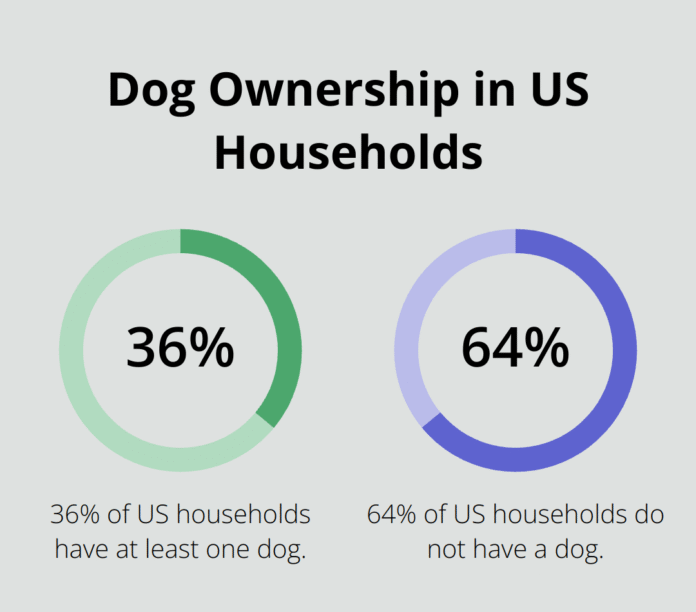“This post contains affiliate links, and I will be compensated if you make a purchase after clicking on my links.”
Living with a dog in an apartment can be challenging, but it’s not impossible. At DogingtonPost, we understand the unique needs of urban pet owners.
Our apartment dog tips will help you transform your space into a safe and comfortable haven for your furry friend. From creating secure areas to maximizing comfort and entertainment, we’ll guide you through practical solutions for harmonious apartment living with your canine companion.
How to Create a Safe Haven for Your Dog
Creating a safe space for your dog in an apartment is essential for their well-being and your peace of mind. A study by the American Veterinary Medical Association found that 36% of households have at least one dog, which emphasizes the need to address safety concerns in smaller living spaces.
Eliminate Hazards
Start with a thorough sweep of your apartment to remove potential dangers. Common household items like chocolate, grapes, and certain houseplants can be toxic to dogs. Get help from Poison Control ONLINE or by PHONE, 24/7 if you suspect your dog has ingested something harmful.
Keep medications, cleaning supplies, and small objects that could be choking hazards out of your dog’s reach. Use childproof locks on low cabinets to prevent curious paws from accessing harmful substances.
Secure Your Space
Loose wires and cords pose a significant risk to dogs who might chew on them. This can damage your electronics and lead to electrical burns or shocks. Use cord covers or tape them securely to baseboards to keep them out of reach.
For areas you want to keep off-limits, baby gates are an excellent solution. They allow you to section off parts of your apartment without completely closing doors, maintaining an open feel while ensuring your dog’s safety.
Prevent Slips and Falls
Slippery surfaces can be particularly dangerous for dogs, especially seniors or those with mobility issues. The American Kennel Club recommends using non-slip mats in areas with smooth flooring to provide traction and prevent accidents.
Place these mats in high-traffic areas, near food and water bowls, and in the bathroom. This simple addition can significantly reduce the risk of injuries from falls and make your dog feel more confident moving around the apartment.
Create a Cozy Retreat
Dogs need a space to call their own, especially in smaller apartments. Set up a comfortable bed or crate in a quiet corner of your home. This gives your dog a safe place to retreat when they feel overwhelmed or need some alone time.
Add some soft blankets and a few favorite toys to make the space inviting. Creating a personal space for your dog can promote security, encourage independence, reduce stress and anxiety, aid in training and behavior management, and enhance their overall well-being.
Now that you’ve created a safe environment for your furry friend, it’s time to focus on maximizing their comfort and entertainment within your apartment space.
How to Keep Your Dog Happy in a Small Space
The Perfect Bed for Your Pup
A good night’s sleep improves your dog’s well-being. Select a bed that fits your dog’s size and sleeping style. Large breeds that stretch out need rectangular beds at least 6 inches longer than their body length. Small dogs who curl up prefer round beds with raised sides for security.
Orthopedic beds benefit senior dogs or those with joint issues. These beds distribute weight evenly and reduce pressure points, which leads to better sleep and less pain. Memory foam beds work well for older dogs or those recovering from surgery (as recommended by the American Kennel Club).
Creating a Play Paradise
You can set up a designated play area for your dog even in a small apartment. Use a corner of your living room or a spare room if available. Define the space with a washable, non-slip rug to protect your floors. Include various toys to keep your dog mentally stimulated.
Switch toys regularly to maintain interest. Dogs show more interest in new toys, which suggests that novelty matters for canine enrichment (according to a study in the journal Animal Cognition). Store a selection of toys and swap them out weekly to keep playtime exciting.

Mental Stimulation is Key
Interactive toys and puzzles keep your dog’s mind active, especially when you’re not home. Aim for 45 minutes of chewing, licking, or sniffing every day. Snuffle mats are great for this purpose. You can even create a simple DIY version by crinkling up a towel or two on the floor and hiding treats in it.
Advanced dogs enjoy puzzle toys with sliding compartments or hidden treats. These toys challenge your dog’s problem-solving skills and can prevent boredom-related behaviors like excessive barking or destructive chewing.
The Importance of a Personal Space
Every dog needs a quiet spot to retreat when feeling overwhelmed or needing alone time. A crate or a cozy corner with a bed serves this purpose. If using a crate, ensure it’s large enough for your dog to stand up, turn around, and lie down comfortably.
Make this space inviting with soft blankets and a few favorite toys. Place it in a quiet area of your apartment, away from high-traffic zones. This personal space also helps with house training puppies or providing a safe area during parties or when guests visit.
Now that you’ve created a comfortable and stimulating environment for your dog, let’s explore practical solutions for apartment living with your furry friend.
Apartment Living Hacks for Dog Owners
Potty Training Solutions
Potty training in an apartment presents unique challenges, especially for high-floor residents. Indoor dog potties can solve this problem. These are particularly useful for potty training, dogs with mobility issues, and older pets who need frequent bathroom breaks. The American Kennel Club suggests consistent use of these tools to establish a routine. Place them in a designated area, preferably near the door you use for walks, to help your dog associate the area with bathroom breaks.
For an eco-friendly option, consider a real grass delivery service. These services provide fresh patches of real grass delivered to your doorstep regularly. This gives your dog a more natural feel and smell, which can ease the transition to outdoor potty breaks when the time comes.
Odor Management Techniques
Living in close quarters with a dog requires effective odor control. An air purifier with a HEPA filter can remove pet dander and odors from the air. The Environmental Protection Agency states that HEPA filters remove at least 99.97% of airborne particles.

Enzymatic cleaners tackle pet odors at the source. These cleaners break down the proteins in urine and feces that cause odors, rather than just masking them. Keep a spray bottle of enzymatic cleaner handy for quick clean-ups.
Regular grooming also controls odors. Daily brushing removes loose fur and distributes natural oils throughout their coat. This reduces shedding and helps control that “doggy smell.”
Noise Reduction Strategies
Barking can become a major issue in apartments. Address the root cause of excessive barking through training and mental stimulation. Provide plenty of toys and puzzles to keep your dog occupied when you’re not home.
For unavoidable noise, try soundproofing techniques. Use heavy curtains or soundproof curtains to absorb noise. Place foam tiles on walls shared with neighbors to reduce sound transmission. These steps not only keep your neighbors happy but also create a more peaceful environment for your dog.
A tired dog is often a quiet dog. Ensure your furry friend gets plenty of exercise to reduce restlessness and potential noise-making behaviors.
Space-Saving Solutions
In small apartments, every inch counts. Opt for multi-functional furniture that doubles as storage for dog supplies. An ottoman with hidden storage can house toys and treats, while a wall-mounted shelf can hold leashes and grooming tools.
Consider vertical space for your dog’s belongings. Install floating shelves for toys or a wall-mounted food and water bowl station. This frees up floor space and keeps your apartment tidy.
Creating a Dog-Friendly Routine
Establish a consistent daily routine for your dog. This includes regular feeding times, walks, and playtime. A structured schedule helps your dog feel secure and reduces anxiety in the confined space of an apartment.
Incorporate indoor exercise into your routine on days when outdoor activities aren’t possible. Try games like hide-and-seek or indoor fetch (with soft toys) to keep your dog active. Mental stimulation games (like treat-dispensing puzzles) can also tire out your dog without requiring much space.
Final Thoughts
Creating a dog-friendly apartment requires thoughtful planning and adaptability. You can transform your living space into a safe, comfortable, and enriching environment for your furry companion with our apartment dog tips. We prioritize safety, comfort, and entertainment to keep your dog mentally and physically stimulated in your urban home.
Practical solutions like indoor potty options, odor management techniques, and noise reduction strategies contribute to harmonious apartment living with your dog. These adjustments benefit your pet and create a more pleasant living experience for you and your neighbors. As your dog grows and changes, reassess and modify your apartment setup to meet their evolving needs.
At DogingtonPost, we understand the unique challenges of raising a dog in an apartment. We provide the latest information and resources for responsible dog ownership. Our health, nutrition, and lifestyle tips support you in creating the best possible life for your apartment-dwelling canine companion.

